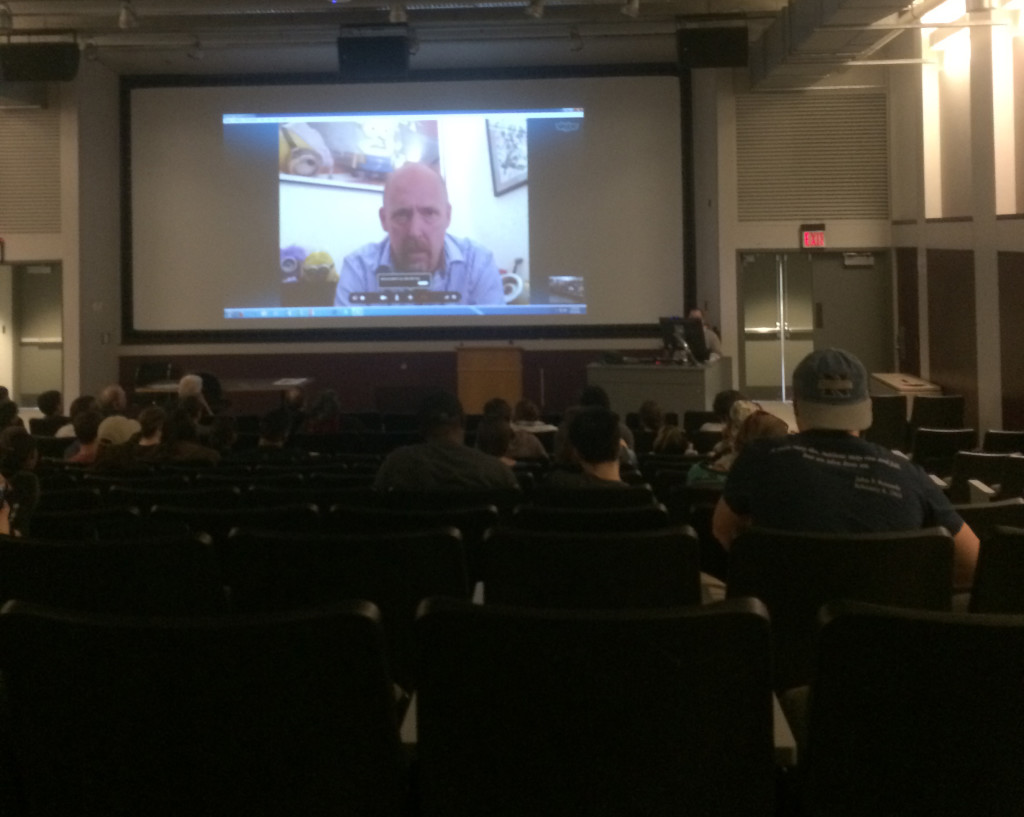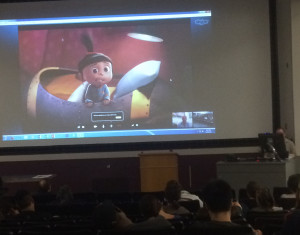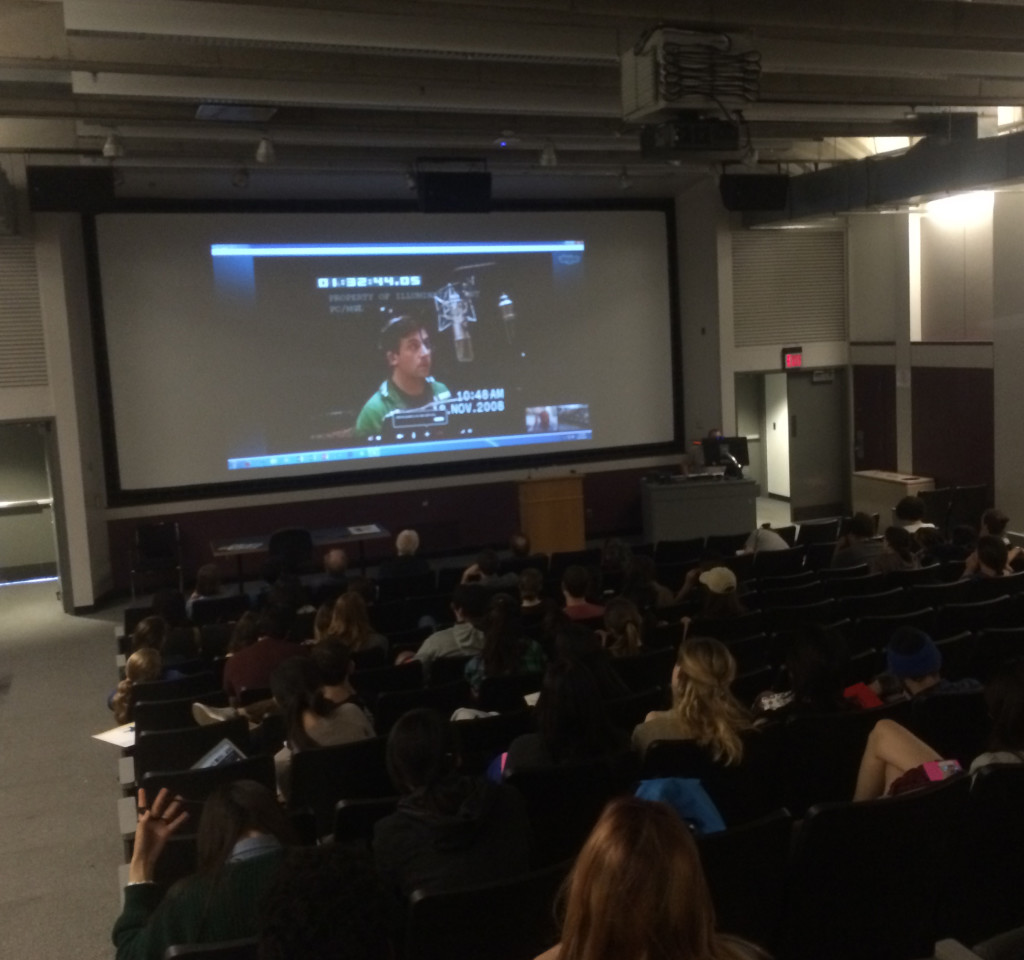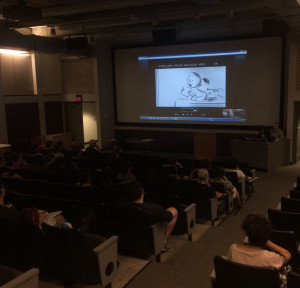The room is dim. 70+ college students in jeans, hipster gear, and pajamas sit up in their seats and giggle, mesmerized by a giant, friendly Wizard of Oz-like head projected in front of them that walks them through a series of illustrations as if reading the children a storybook and acting out all the voices. One would expect a popcorn and candy stand nearby.
Nope.
This is Syracuse University’s Illustration Symposium talking to Despicable Me Director Chris Renaud from his home 3,000 miles away in Paris, France as he walks them through what it takes to develop a popular animated feature from start to finish.

Photo: Joe Cunningham
On the right, behind a podium and desktop computer is the professor: Timothy Coolbaugh. Coolbaugh grew up in Michigan, earned both his BFA and MFA in illustration from Syracuse and has been working as an artist for 25 years. He has served as an adjunct professor at SU since 2000.
“I’ve been teaching this class since 2007,” says Coolbaugh, “The goal is to put the student in contact with the illustrators, art directors, art reps, and animators that are working in the field right now.” Coolbaugh explained that many of the speakers comment on how they envy the students for this class.
Schools with competitive programs in NYC do not have a class like this.

Photo: Joe Cunningham
“They will tell them if they want to meet someone to look them up in the phone book and go over and talk to them. This can be very intimidating to a neophyte,” said Coolbaugh, “I know I couldn’t do it.” The class is a gentler way to introduce them to the different possibilities out there. Students have secured internships, jobs, and found mentors from meeting presenters for the first time during the class.
Coolbaugh recalled the “old way” of class presentation via twenty slide carousels (things millennials know nothing about) as opposed to today’s class presenter that can fit every slideshow image they need onto one thumb drive. However, the most significant technological advance to his classroom came from an innovation Coolbaugh had two years before.
“In an effort to cut costs, reduce our carbon footprint, and to reach out to people that were too far or too busy to come to Syracuse, I suggested we start doing a few Skype visits a semester,” he said, “At the time I didn’t really know what Skype was.”
The class coordinators agreed to the initiative and the “visit” was a great success. The Manhattan based artist would not have made it to the school that day because of a snow storm that was occurring downstate.
“Since then we’ve done five Skype classes,” said Coolbaugh. The professor mentioned Skype’s recently updated system has made it even easier for them to present an art class: adding the user-friendly option to share computer screens with no lag time, something the Despicable Me creator did continuously while walking the students through story boards, concept art, 3D camera, Steve Carrell recording sessions, and animation development until the final cut of the film.
The filmmaker leaned forward from his Parisian abode to answer questions about his favorite influencers (comic book artists, Star Wars concept artists, and Chuck Jones); talk about developing “Scrat” for the Ice Age Blue Sky films, product placement, the “Happy” Despicable sequel, and The Lorax – another Renaud film.

Photo by Joe Cunningham
“We would put an image up of the character next to an image of an actor and then play the actor’s voice,” said Renaud, describing how casting was done for the animated films. The director chuckled as he recalled casting Danny DeVito as the title character from The Lorax.
“We played this line from Always Sunny in Philadelphia which was something like ‘Up there between two broads, just me with my thumbs up’ – and it was just perfect,” laughed Renaud.
Renaud, a 1989 graduate of Syracuse University, reminisced for a while about his comic book days, transforming scripts into graphic novels alone in 22 days, starting Despicable Me in his basement with literally nothing but some rudimentary pencils and paper, and if he had to go back he “wouldn’t change a thing.”

Over break room cooler water and Keurig coffee, Coolbaugh underlined what he thought was the biggest contribution technology has made since he was an undergrad.
“Making information more accessible,” he answered, “When I was a student and had to write a paper I had to go to the library and find books or magazines that had the information I wanted. Now a student wouldn’t even have to leave their dorm room to get the information they need since much of it is on the internet.” Coolbaugh also underlined the danger in this since “everyone else is traveling down the same path.”
“That’s why in the term paper I make my students write – they have to have at least two sources that are not electronically generated. It makes them think outside the box.” Quite literally.
“Some students today feel they have to be on their phones and laptops all the time,” said the professor, “I don’t allow them in my classroom because it’s distracting to the student and to the guest,” he said. Coolbaugh added that it wouldn’t be a problem if the students were taking notes.
“But they aren’t,” said the professor of 14 years.
The syllabus is full every semester with noteworthy persons of interest in the illustration world, perfect for the illustration and animation majors that attend the symposium.
“Chris Renaud has been the biggest name we’ve Skyped with but I’m sure we will add to that list,” said Coolbaugh, saying he loved the class because, as an artist, he gets to “hang out with his heroes for the day” – and his bucket list, he says, is getting smaller and smaller.
“After a student has graduated,” said the professor, “They will be able to go through a Society of Illustrators Annual or animated movie’s credits and say, ‘I’ve met that person and that person.’”
When asked what advice he would offer art students of this ever-technologically-advancing age, Coolbaugh had this to say:
“Draw, draw, draw. Recruiters used to come on campus looking for students that would good at Photoshop or Illustrator. A few years ago that changed. Now they look for students that draw well.”
“One of my colleagues, Bob Dacey, asked why the change,” he said, “The recruiter replied, ‘We can teach someone a program in less than six months; it takes years to learn how to draw.’”
***





